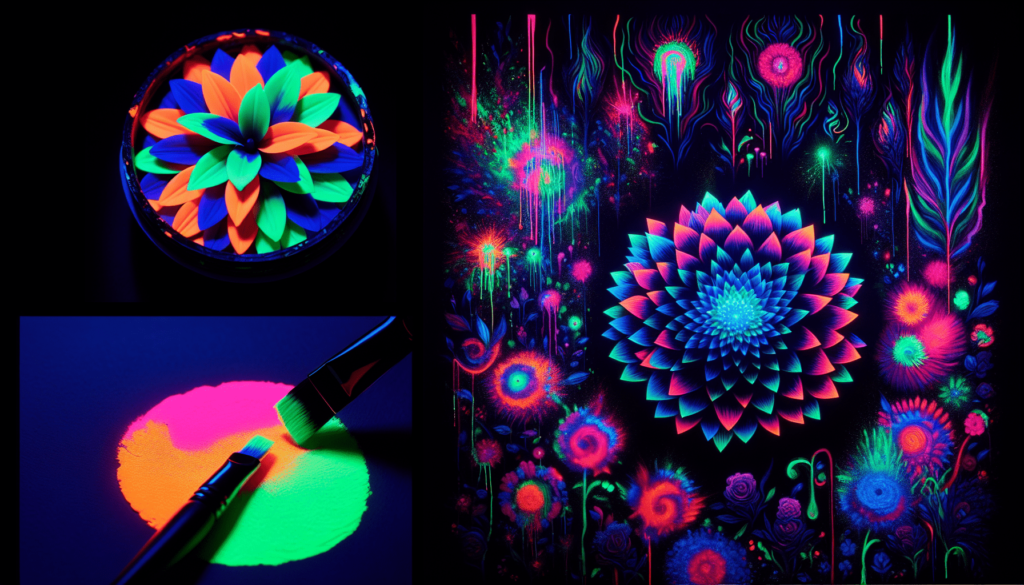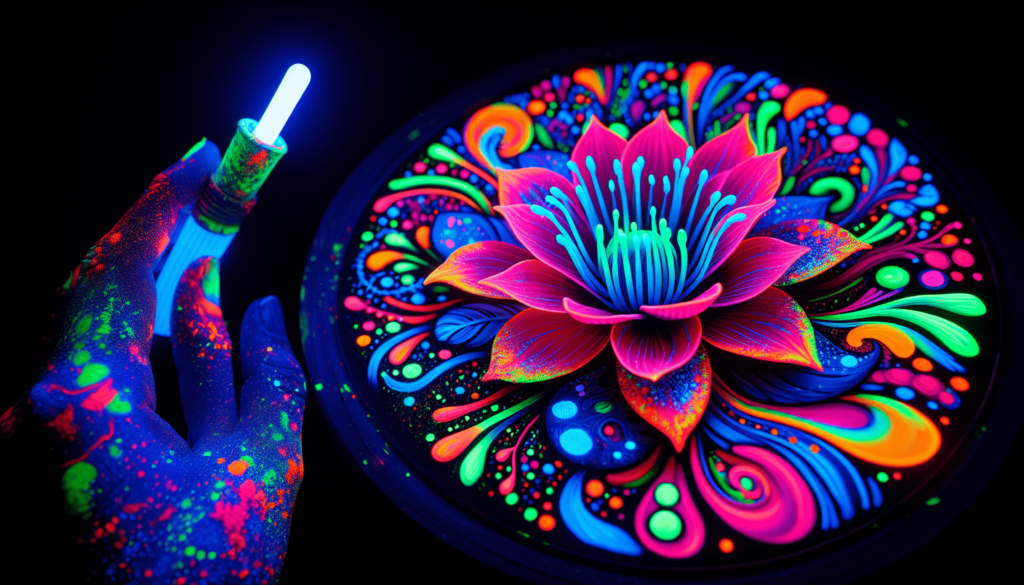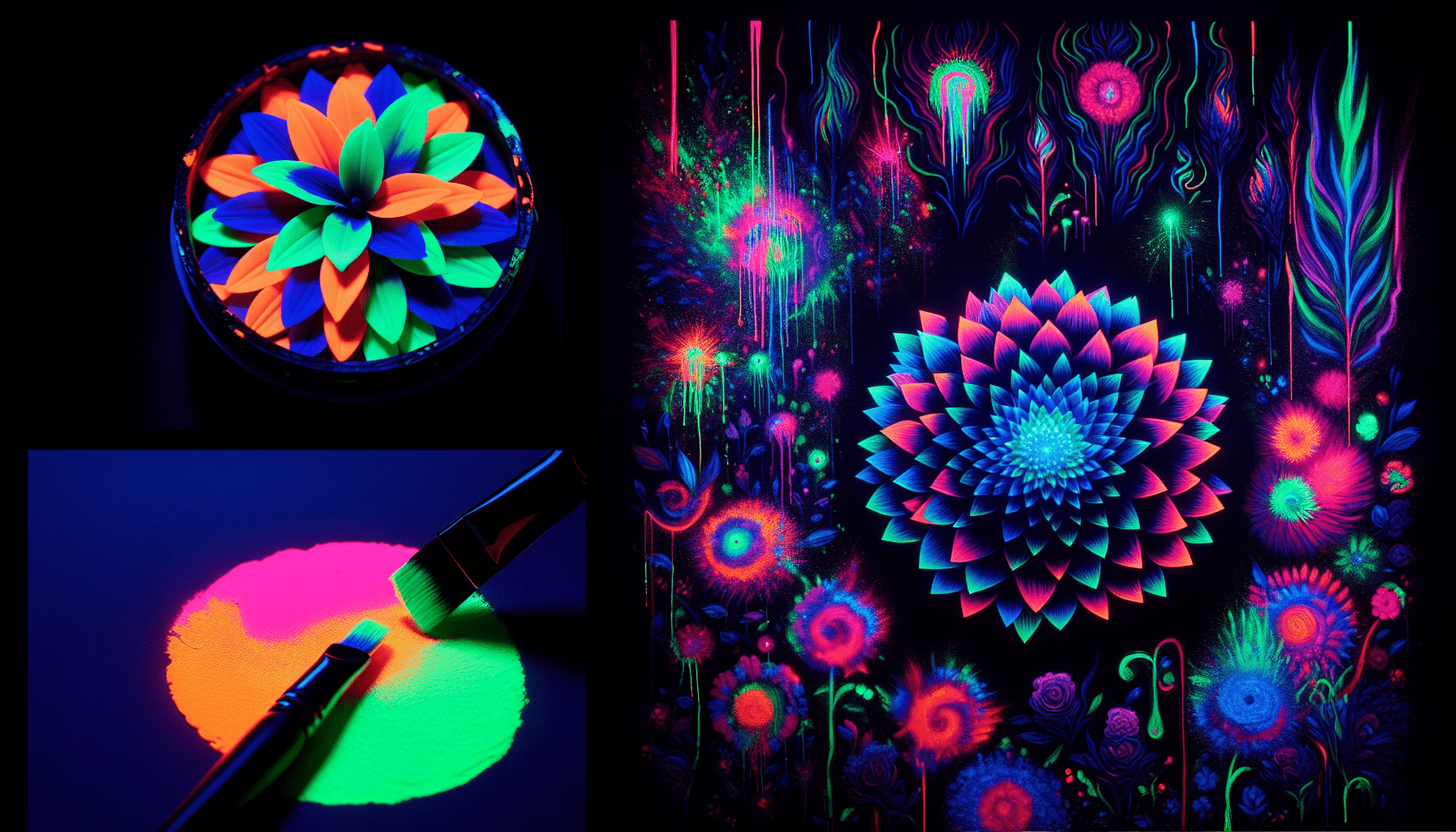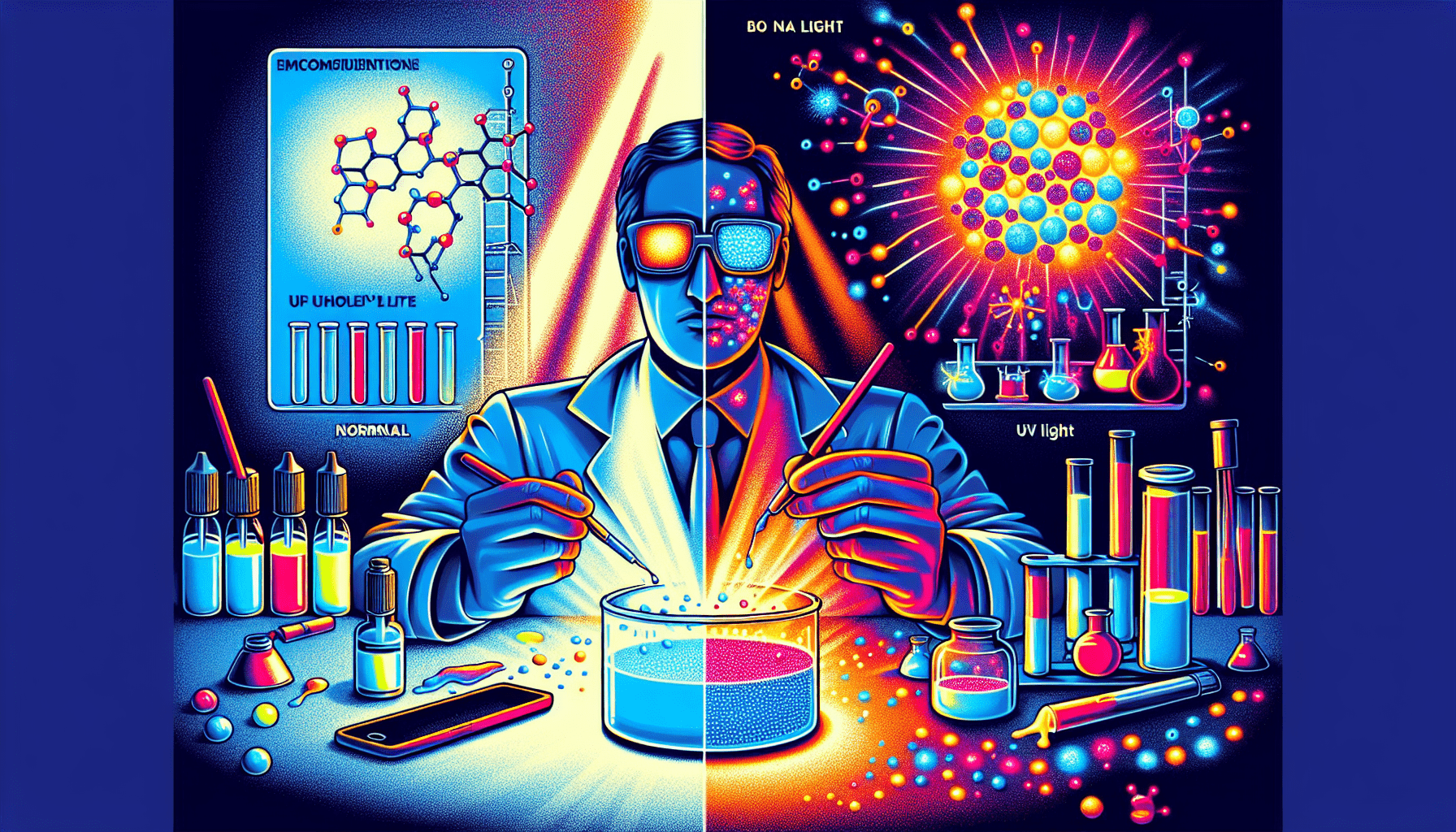Fluorescent paint has long been admired for its vibrant and eye-catching colors, but have you ever wondered if it is UV reactive too? In this article, we will explore the fascinating world of fluorescent paint and its unique relationship with ultraviolet light. By delving into the science behind its glowing properties, we aim to shed light on whether fluorescent paint truly reacts to UV rays and what implications this may have for various applications. So, let’s embark on this illuminating journey and discover the secrets behind the mesmerizing allure of fluorescent paint.
What is fluorescent paint?
Definition of fluorescent paint
Fluorescent paint is a type of paint that emits vibrant and intense colors when exposed to ultraviolet (UV) light. It contains fluorescent pigments that absorb UV radiation and convert it into visible light, resulting in a luminescent effect. These pigments are made using special compounds that fluoresce, or emit light, when excited by UV rays.
Properties of fluorescent paint
Fluorescent paint possesses several unique properties that make it distinct from conventional paints. Firstly, it exhibits an exceptional brightness and intensity, creating a vivid and eye-catching appearance. Additionally, it offers a wide range of vibrant colors, including neon shades, which can enhance the visual impact of any application. Furthermore, it has excellent lightfastness, meaning it resists fading or dulling when exposed to prolonged periods of UV light. This makes fluorescent paint a long-lasting option for both indoor and outdoor use.
What is UV reactive paint?
Definition of UV reactive paint
UV reactive paint, also known as blacklight paint, is a type of paint that has the ability to glow or fluoresce under UV light. It contains phosphors, which are materials that emit visible light when excited by UV radiation. UV reactive paint is often used in environments where the presence of UV light is desired or where a unique and colorful effect is needed.
Properties of UV reactive paint
UV reactive paint shares some similarities with fluorescent paint, but it has distinct properties as well. Like fluorescent paint, it produces vibrant and intense colors when exposed to UV light. However, UV reactive paint tends to produce a more luminous and glowing effect, giving objects and surfaces an otherworldly appearance. It typically comes in a range of colors, including ones that are not traditional fluorescent shades, expanding the possibilities for creative applications. UV reactive paint also has good lightfastness, ensuring that the glowing effect remains visible over time.

Is fluorescent paint UV reactive?
Exploring the connection between fluorescent paint and UV reactivity
While fluorescent paint and UV reactive paint are often mentioned together, it is important to understand that they are not synonymous. Fluorescent paint primarily relies on the conversion of UV light into visible light to create its vibrant colors, whereas UV reactive paint directly reacts to UV light to produce a glowing effect.
Although fluorescent paint may react to UV light and appear to fluoresce, it is not considered truly UV reactive. The fluorescent pigments in the paint absorb UV rays and re-emit them as visible light, resulting in a bright and colorful appearance. However, when exposed to UV light sources such as blacklights, fluorescent paint may exhibit enhanced visibility and intensity due to the presence of UV radiation.
Testing and measuring UV reactivity of fluorescent paint
To determine the UV reactivity of fluorescent paint, various methods can be employed. One approach is to use a UV meter, which measures the amount of UV radiation emitted by a light source. By comparing the UV levels before and after applying the paint, the UV reactivity can be evaluated.
Another method involves exposing the painted surface to a well-calibrated UV light source and observing the intensity of the fluorescent response. By examining the brightness, duration, and consistency of the fluorescent effect, the UV reactivity can be assessed.
It is worth noting that the UV reactivity of fluorescent paint can be influenced by factors such as the type of fluorescent pigments used, the quality and formulation of the paint, the thickness of the paint application, and the duration of exposure to UV light.
Factors affecting UV reactivity of fluorescent paint
Type of fluorescent pigments used
The choice of fluorescent pigments plays a crucial role in determining the UV reactivity of fluorescent paint. Different types of pigments have varying levels of UV absorption and fluorescence properties. Some pigments are specifically designed to enhance UV reactivity, while others may have a lesser response to UV light. Therefore, selecting the right type of fluorescent pigments can significantly impact the overall UV reactivity of the paint.
Quality and formulation of fluorescent paint
The quality and formulation of fluorescent paint can greatly influence its UV reactivity. Higher-quality paints often contain a higher concentration of fluorescent pigments, resulting in a stronger and more pronounced fluorescent effect. The presence of additional additives and binders in the paint formulation can also affect the UV reactivity. Therefore, investing in paints with reliable quality and formulation is essential to achieve optimal UV reactivity.
Thickness of paint application
The thickness of the paint application can affect the UV reactivity of fluorescent paint. Thicker layers of paint allow for more absorption of UV radiation and subsequent conversion into visible light. Consequently, applying multiple coats or ensuring a sufficient thickness can enhance the overall UV reactivity of the paint.
Exposure time to UV light
The duration of exposure to UV light can influence the UV reactivity of fluorescent paint. Longer exposure times to UV light sources, such as blacklights, can intensify the fluorescent effect. This is because the fluorescent pigments have more time to absorb UV radiation and emit visible light, resulting in a more vibrant and glowing appearance. Hence, the duration of exposure should be considered when evaluating the UV reactivity of fluorescent paint.

Applications of fluorescent and UV reactive paint
Artistic and creative uses
Fluorescent and UV reactive paint find extensive applications in the artistic and creative fields. From mural paintings and street art to stage and concert productions, these paints can add a captivating and dynamic element to various artistic endeavors. The vibrant and glowing colors create a stunning visual impact, making them ideal for creating immersive experiences and capturing attention.
Safety and security applications
In safety and security applications, fluorescent and UV reactive paint serve as valuable tools. For example, road marking and signage painted with fluorescent and UV reactive paint increase visibility during low light conditions, enhancing road safety. Similarly, in industrial facilities or emergency escape routes, fluorescent and UV reactive paint can be used to mark paths or objects, ensuring clear visibility in dark or hazardous environments.
Industrial and commercial uses
In the industrial and commercial sectors, fluorescent and UV reactive paint offer versatile applications. They are often used for product branding, packaging, and advertising displays, allowing companies to create attention-grabbing visuals and stand out in crowded marketplaces. Furthermore, in the manufacturing and production industries, these paints can be utilized for quality control purposes, enabling the detection of flaws or irregularities that may not be visible with conventional lighting.
Advantages and disadvantages of fluorescent and UV reactive paint
Advantages of using fluorescent and UV reactive paint
One of the significant advantages of fluorescent and UV reactive paint is their ability to create visually striking effects. The vibrant colors and glowing appearance can draw attention and make a lasting impression in various applications. Additionally, the lightfastness of these paints ensures that the intense colors remain vivid over time, making them durable and resistant to fading.
Another advantage is the wide range of colors available. Fluorescent and UV reactive paint offer an extensive palette of hues, including neon shades, which can be used to create unique and eye-catching designs. This versatility opens up numerous possibilities for creative expression in both artistic and commercial settings.
Disadvantages and limitations of fluorescent and UV reactive paint
While fluorescent and UV reactive paint offer many advantages, there are also some limitations to consider. One limitation is their reliance on UV light sources to achieve the desired effect. Without proper UV lighting, the fluorescent and glowing properties of the paint may not be fully realized. This dependence on external lighting conditions can restrict the applications of these paints to environments where UV or blacklight sources are available.
Another limitation is the need for careful maintenance and protection. Fluorescent and UV reactive paint may require periodic touch-ups or reapplication due to factors such as weathering, physical wear, or degradation over time. Additionally, certain environments or chemicals may affect the UV reactivity or fluorescence of the paint, necessitating regular maintenance and care.
Tips for using fluorescent and UV reactive paint effectively
Choosing the right paint and pigments
When using fluorescent and UV reactive paint, it is crucial to select the appropriate paint and pigments for the desired application. Consider factors such as the UV reactivity, color range, lightfastness, and formulation of the paint. Conduct research and experimentation to determine which paint and pigments best suit your specific needs.
Preparation and application techniques
Proper preparation and application techniques are essential for achieving the desired results. Ensure that the surface to be painted is clean, dry, and free of contaminants, as this can affect adhesion and overall performance. When applying the paint, follow the manufacturer’s instructions regarding the recommended number of coats, drying times, and application methods. These guidelines will help optimize the UV reactivity and longevity of the fluorescent and UV reactive paint.
Proper maintenance and care
To maintain the UV reactivity and appearance of fluorescent and UV reactive paint, proper maintenance and care are essential. Regularly inspect the painted surface for any signs of wear, fading, or degradation. If necessary, consider applying additional coats or touch-ups to maintain the vibrancy of the colors. Protect the painted surface from harsh weather conditions, excessive sunlight exposure, and chemicals that may affect the UV reactivity. By taking proactive measures, you can prolong the lifespan and effectiveness of the fluorescent and UV reactive paint.
Safety considerations when working with fluorescent and UV reactive paint
Wearing protective gear
When working with fluorescent and UV reactive paint, it is crucial to prioritize safety. Wear appropriate personal protective equipment (PPE), including gloves, safety glasses, and a respirator if required. This will help protect against potential hazards, such as skin irritation or respiratory issues, from prolonged exposure to the paint or its fumes.
Proper ventilation
Ensure that the work area is well-ventilated to prevent the accumulation of paint fumes or volatile organic compounds (VOCs) released during the painting process. Open windows, use fans, or work in a dedicated spray booth, if available, to promote air circulation and minimize exposure to potentially harmful substances.
Safe disposal of materials
Dispose of any waste materials, such as empty paint cans and used brushes or rollers, in a responsible manner. Follow local regulations and guidelines for the proper disposal or recycling of paint-related waste. Avoid pouring excess paint or cleaning solutions down drains or into the environment, as this can contribute to pollution and harm ecosystems.
Conclusion
Fluorescent paint and UV reactive paint are fascinating and visually captivating materials that offer unique properties for a range of applications. While Fluorescent paint exhibits vibrant colors through the conversion of UV light into visible light, UV reactive paint directly reacts to UV light to produce a glowing effect. Understanding the differences between these two types of paint is crucial when considering their applications.
The UV reactivity of fluorescent paint can be influenced by factors such as the type of pigments used, the quality and formulation of the paint, the thickness of application, and the duration of exposure to UV light. By considering these factors, one can optimize the UV reactivity of fluorescent paint for different purposes.
Fluorescent and UV reactive paint find applications in both artistic and commercial settings, offering advantages such as vibrant and intense colors, high lightfastness, and versatile visual effects. However, it is important to be aware of their limitations, such as the dependency on external UV light sources and the need for proper maintenance.
To use fluorescent and UV reactive paint effectively, it is essential to choose the right paint and pigments, follow proper preparation and application techniques, and ensure proper maintenance and care. Additionally, safety considerations, including wearing protective gear, maintaining proper ventilation, and practicing safe disposal methods, should be prioritized when working with these paints.
As technology and materials continue to advance, potential future developments and advancements in fluorescent and UV reactive paint may offer even more exciting possibilities in creating visually stunning and unique effects.



